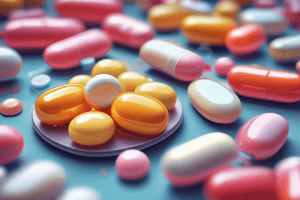Podcast
Questions and Answers
Which type of bacteria is penicillin effective against?
Which type of bacteria is penicillin effective against?
- Neither Gram-positive nor Gram-negative bacteria
- Only Gram-negative bacteria
- Only Gram-positive bacteria
- Both Gram-positive and some Gram-negative bacteria (correct)
What is the mechanism of action of penicillin?
What is the mechanism of action of penicillin?
- It inhibits the synthesis of bacterial DNA
- It inhibits the synthesis of bacterial proteins
- It increases the permeability of the bacterial cell membrane
- It blocks the cross-linking of peptidoglycan chains (correct)
Which of the following infections is penicillin used to treat?
Which of the following infections is penicillin used to treat?
- Urinary tract infections
- Viral infections
- Fungal infections
- Pneumonia (correct)
What is the classification of penicillin?
What is the classification of penicillin?
What is a concern regarding the use of penicillin?
What is a concern regarding the use of penicillin?
What is an example of a natural penicillin?
What is an example of a natural penicillin?
Study Notes
Pharmacology
- Mechanism of Action: Penicillin works by inhibiting the synthesis of the bacterial cell wall, specifically by blocking the cross-linking of peptidoglycan chains.
- Classification: Penicillin is a type of beta-lactam antibiotic, which is a class of antibiotics that includes cephalosporins, carbapenems, and monobactams.
- Types: There are several types of penicillin, including:
- Natural penicillins (e.g. penicillin G)
- Semisynthetic penicillins (e.g. ampicillin, amoxicillin)
- Synthetic penicillins (e.g. piperacillin)
Bacterial Infections
- Spectrum of Activity: Penicillin is effective against a wide range of bacterial infections, including:
- Gram-positive bacteria (e.g. Staphylococcus, Streptococcus)
- Some Gram-negative bacteria (e.g. Neisseria, Haemophilus)
- Indications: Penicillin is used to treat various infections, including:
- Pneumonia
- Meningitis
- Skin and soft tissue infections
- Bone and joint infections
- Endocarditis
- Resistance: Bacterial resistance to penicillin has become a significant concern, with many bacteria producing beta-lactamases that can break down the antibiotic.
Pharmacology of Penicillin
- Penicillin's mechanism of action involves inhibiting bacterial cell wall synthesis by blocking peptidoglycan chain cross-linking.
- Penicillin is classified as a beta-lactam antibiotic, a class that also includes cephalosporins, carbapenems, and monobactams.
Types of Penicillin
- Natural penicillins include penicillin G.
- Semisynthetic penicillins include ampicillin and amoxicillin.
- Synthetic penicillins include piperacillin.
Bacterial Infections and Penicillin
- Penicillin is effective against a wide range of bacterial infections, including Gram-positive bacteria like Staphylococcus and Streptococcus.
- Penicillin is also effective against some Gram-negative bacteria, such as Neisseria and Haemophilus.
Indications for Penicillin Use
- Penicillin is used to treat pneumonia.
- Penicillin is used to treat meningitis.
- Penicillin is used to treat skin and soft tissue infections.
- Penicillin is used to treat bone and joint infections.
- Penicillin is used to treat endocarditis.
Penicillin Resistance
- Bacterial resistance to penicillin has become a significant concern.
- Many bacteria produce beta-lactamases that can break down penicillin.
Studying That Suits You
Use AI to generate personalized quizzes and flashcards to suit your learning preferences.
Description
This quiz covers the mechanism of action and classification of penicillin, including its effect on bacterial cell walls and its various types.




